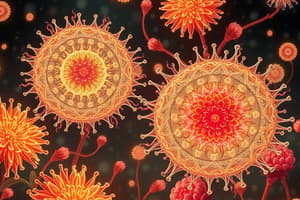Podcast
Questions and Answers
What is the process called by which a single endospore forms within some bacteria?
What is the process called by which a single endospore forms within some bacteria?
- Dipicolination
- Endosporulation (correct)
- Sporulation
- Peptidoglycanation
What is the function of dipicolinic acid in endospore formation?
What is the function of dipicolinic acid in endospore formation?
- To facilitate the release of the endospore from the mother cell
- To create the spore coat
- To stabilize the proteins and DNA in the endospore (correct)
- To form the peptidoglycan cortex
What is the structure that surrounds the core of the endospore?
What is the structure that surrounds the core of the endospore?
- Peptidoglycan cortex
- Outer membrane
- Spore coat
- Inner membrane (correct)
What is the final stage of endospore formation?
What is the final stage of endospore formation?
What is the unique feature of the endospore that is not found in vegetative cells?
What is the unique feature of the endospore that is not found in vegetative cells?
What is the purpose of the cortex in the endospore?
What is the purpose of the cortex in the endospore?
What is the approximate percentage of water in the cytoplasm of a prokaryotic cell?
What is the approximate percentage of water in the cytoplasm of a prokaryotic cell?
What is the primary function of the cytoplasm in a prokaryotic cell?
What is the primary function of the cytoplasm in a prokaryotic cell?
What is the function of mesosomes in prokaryotic cells?
What is the function of mesosomes in prokaryotic cells?
What is the characteristic of the chromosome in a prokaryotic cell?
What is the characteristic of the chromosome in a prokaryotic cell?
What is the function of plasmids in prokaryotic cells?
What is the function of plasmids in prokaryotic cells?
What is the role of some plasmids in antibiotic resistance?
What is the role of some plasmids in antibiotic resistance?
What is the function of conjugative plasmids?
What is the function of conjugative plasmids?
What is the characteristic of the nucleoid in a prokaryotic cell?
What is the characteristic of the nucleoid in a prokaryotic cell?
What is the primary function of ribosomes in all organisms?
What is the primary function of ribosomes in all organisms?
What is the purpose of plasmids in genetic engineering?
What is the purpose of plasmids in genetic engineering?
What is unique about the 70S ribosomes found in prokaryotes?
What is unique about the 70S ribosomes found in prokaryotes?
What is the function of mRNA in protein synthesis?
What is the function of mRNA in protein synthesis?
What is the purpose of inclusion granules in bacteria?
What is the purpose of inclusion granules in bacteria?
What is unique about endospores?
What is unique about endospores?
What is the function of tRNA in protein synthesis?
What is the function of tRNA in protein synthesis?
What is the purpose of Bacillus stearothermophilus spores in quality control?
What is the purpose of Bacillus stearothermophilus spores in quality control?
Flashcards are hidden until you start studying
Study Notes
Bacterial Internal Structures
- Cytoplasm: a gel-like matrix composed of 80% water, containing nucleic acids, enzymes, amino acids, carbohydrates, lipids, inorganic ions, and low molecular weight compounds, and is the site of most bacterial metabolism that leads to growth and replication.
- Mesosomes: plasma membrane infoldings that aid in:
- Cell wall formation
- DNA replication in prokaryotes
- Increasing plasma membrane surface area and enzymatic content
- Transferring chromosomes to daughter cells
- Nucleoid:
- A region with a single circular chromosome of double-stranded, supercoiled DNA
- No nuclear membrane or nucleoli
- Chromosome size varies from 580,000 base pairs in Mycoplasma gallinarum to 9,140,000 bp in Myxococcus xanthus
Plasmids
- Small, nonessential, extra-chromosomal DNA molecules that:
- Can confer protective traits such as drug resistance or toxin production
- Can be passed on during conjugation
- Replicate independently
- Can be gained or lost by bacteria
- Conjugative plasmids allow for the exchange of DNA between bacterial cells
- Plasmids are useful tools in genetic engineering/rDNA Technology
Ribosomes
- The most abundant component in the cytoplasm, with up to 15,000 ribosomes
- Site of protein synthesis in all organisms
- Prokaryotic ribosomes are 70S, composed of a 50S subunit and a 30S subunit
- Function as a workbench for protein synthesis, translating mRNA into proteins
Inclusion Granules
- Nonliving components that do not possess metabolic activity
- Not bounded by membranes
- Examples:
- Volutin granules (inorganic phosphate)
- Polysaccharide granules (glycogen or starch)
- Lipid inclusions (e.g., PHB granules)
- Sulfur and nitrogen granules
- Gas vacuoles (in some aquatic bacteria)
Endospores
- Dormant, resistant structures produced intracellularly upon starvation
- Resistant to:
- High temperatures
- Irradiation
- Cold
- Organic solvents
- Contain calcium dipicolinate
- Not a mechanism of reproduction
- Examples: Bacillus and Clostridium sp.
Endosporulation
- Process of forming an endospore, involving:
- DNA replication
- Formation of a spore septum
- Pinching off of the plasma membrane to form a double membrane around the DNA
- Incorporation of calcium dipicolinate
- Formation of a peptidoglycan cortex and spore coat
- Dehydration and maturation of the endospore
Studying That Suits You
Use AI to generate personalized quizzes and flashcards to suit your learning preferences.




